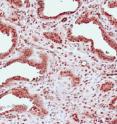Aurora A may contribute to kidney disease
Related images
(click to enlarge)
The Aurora A kinase may contribute to polycystic kidney disease (PKD) by inactivating a key calcium channel in kidney cells, according to a study in the June 13 issue of The Journal of Cell Biology (www.jcb.org). Aurora A is an oncogene best known as a regulator of mitotic progression. But the kinase has important functions during interphase as well, when it can promote cilia disassembly and can be activated by elevated calcium levels. Because both calcium signaling and cilia are defective in PKD, researchers from the Fox Chase Cancer Center in Philadelphia wondered whether Aurora A might contribute to the pathology of this common genetic disease.
The researchers found that Aurora A was up-regulated and activated in epithelial cells lining the cysts in PKD patient kidneys. In addition, Aurora A bound to and phosphorylated a calcium channel called polycystin-2, whose gene, PKD2, is often mutated in autosomal dominant forms of PKD.
Polycystin-2 mediates the release of calcium from storage in the endoplasmic reticulum and calcium influx into cilia. Inhibition or knockdown of Aurora A boosted intracellular calcium levels, but this effect was less pronounced in kidney cells lacking polycystin-2, indicating that Aurora A normally lowers calcium levels by inactivating polycystin-2. Only small doses of inhibitor were required to increase calcium levels, suggesting that Aurora A may be a viable therapeutic target for boosting polycystin-2 activity in certain PKD patients. Senior author Erica Golemis now wants to investigate how Aurora A becomes up-regulated in PKD and whether inhibitors of the kinase can slow cyst formation in mouse models of the disease.
Source: Rockefeller University Press
Other sources
- Aurora A kinase may contribute to kidney diseasefrom Science Daily13 years ago
- Aurora A may contribute to kidney diseasefrom Physorg13 years ago
- Aurora A May Contribute to Kidney Diseasefrom Newswise - Scinews13 years ago


